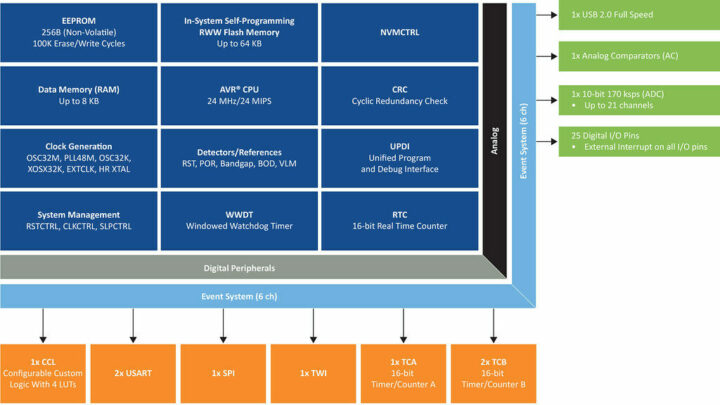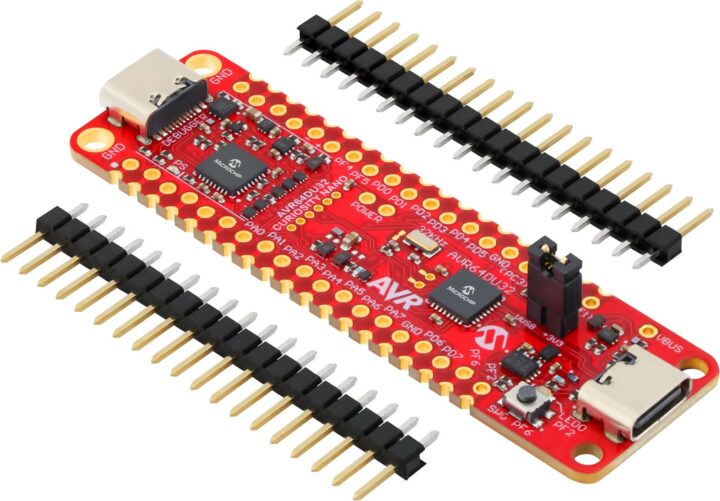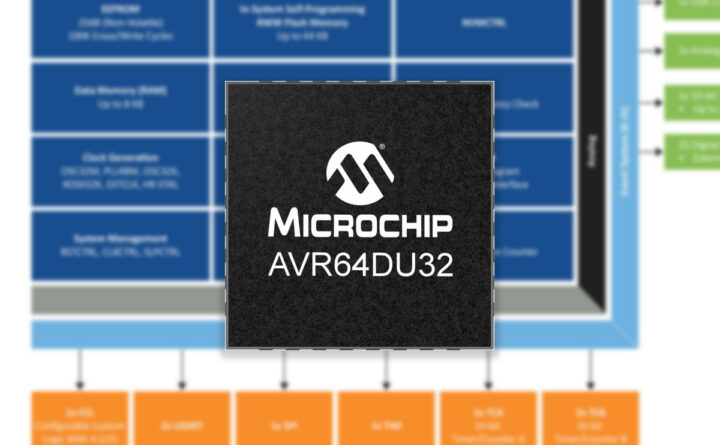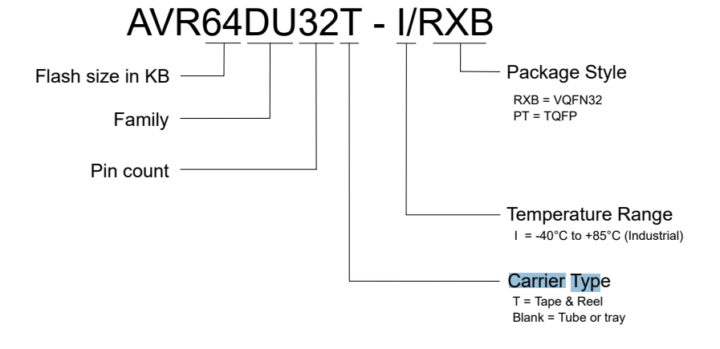At Embedded World 2024, Microchip announced their new AVR DU family of 8-bit MCUs featuring a full-speed USB 2.0 data interface along with USB-C 15W Power Delivery enabling up to 12Mbps data transfer and charging. They also have features like secure bootloaders and Program and Debug Interface Disable (PDID), which protect your embedded designs.
Based on the Harvard architecture, these MCUs can have up to 64 KB of Flash memory, 8 KB of SRAM, and 256 bytes of EEPROM. Their wide operating voltage range of 1.8V to 5.5V makes them suitable for small, space-sensitive devices, power bricks, and rechargeable devices. But one thing to note is that the USB function is only available for VDD above 3.0V and I2C Fm+ (Fast-mode Plus) is only supported for 2.7V and above.
I²C Fm+ extends the standard I²C protocol, boosting communication speeds up to 1 MHz while maintaining compatibility with older I²C devices. It’s a simple upgrade for faster data transfer in applications using sensors, memory, and other I²C devices. This is not the first 8-bit MCU that Microchip has announced, previously we have seen MCUs like PIC16F13145 series, PIC18-Q24 8-bit MCU, and PIC18-Q20. Feel free to check those out if you are looking for 8-bit MCUs.
AVR DU Family MCUs Specifications:
- AVR RISC CPU
- Running at up to 24 MHz
- Single-cycle I/O access
- Two-level interrupt controller
- Two-cycle hardware multiplier
- Program and Debug Interface Disable (PDID)
- Supply voltage range: 1.8-5.5V
- Memories
- 16/32/64 KB in-system self-programmable Flash memory
- 2/4/8 KB SRAM
- 256 Bytes EEPROM
- 512 Bytes of user row in nonvolatile memory
- 256 Bytes of boot row
- Write/erase endurance:
- Flash: 1,000 cycles
- EEPROM: 100,000 cycles
- Data retention: 40 years at 55°C
- System
- Power-on Reset (POR) circuit
- Brown-out Detector (BOD)
- Voltage Level Monitor (VLM) with interrupt
- Clock options:
- High-precision internal high-frequency oscillator with selectable frequency up to 24 MHz (OSCHF)
- Auto-tuning for improved internal oscillator accuracy
- 32.768 kHz internal oscillator (OSC32K)
- 32.768 kHz external crystal oscillator (XOSC32K)
- External clock input
- External high-frequency crystal oscillator (XOSCHF) with clock failure detection
- Single-pin Unified Program and Debug Interface (UPDI)
- Three sleep modes
- Automated Cyclic Redundancy Check (CRC) Flash memory scan
- Watchdog Timer (WDT) with Window mode
- Peripherals
- 1x 16-bit Timer/Counter type A (TCA) with three compare channels
- 2x 16-bit Timer/Counter type B (TCB) with input capture
- 1×16-bit Real-Time Counter (RTC)
- 1x USB 2.0 full-speed (12 Mbps) device-compliant interface
- 2x USARTs with multiple operation modes
- 1x SPI with host/client operation modes
- 1x Two-Wire Interface (TWI) with dual address match
- 1x 10-bit 170 ksps Analog-to-Digital Converter (ADC)
- 1x Analog Comparator (AC)
- Event System for CPU-independent inter-peripheral signaling
- Configurable Custom Logic (CCL) with four programmable Look-up Tables (LUTs)
- Internal voltage references and external reference option (VREF)
- I/O and Packages
- Up to 25 programmable GPIO pins
- Various package options including VQFN, TQFP, SPDIP, SSOP, and SOIC
- Temperature Range – Industrial: -40°C to +85°C
Note! The above specs are for the AVR64DU32, the most feature-rich MCU in the family. While many specifications remain consistent across the series, some may vary depending on your specific MCU.

The DU family features compact 14 to 32-pin MCUs with varying RAM and flash sizes and has features like Configurable Custom Logic (CCL) with four programmable Look-up Tables (LUTs) for Simplified designs, flexible signal control, and Custom protocol support.
Customizable Logic is somewhat similar to programmable logic devices (PLDs), and it’s a key feature in Microchip’s latest MCUs. Configurable Logic Blocks (CLBs) allow you to program logic functions (AND, OR, XOR, etc.) using look-up tables (LUTs). This lets you design custom circuits within the MCU, reducing costs and power consumption compared to using separate components.

To further simplify the development process, Microchip has also released the $24 AVR64DU32 Curiosity Nano, a development board built around the AVR64DU32 MCU. The Curiosity Nano from Microchip is a common platform for development boards that supports a wide range of microcontrollers.
The MCUs are fully compatible with the MPLAB X IDE and MPLAB XC8 C compiler. Additionally, the MPLAB Code Configurator (MCC) includes a USB software stack to manage the MCU’s USB hardware. The company also provides a getting-started guide and sample codes
More information about the AVR DU Family can be found on their product page. You can also find this microcontroller on Microchipdirect and DigiKey.
Debashis Das is a technical content writer and embedded engineer with over five years of experience in the industry. With expertise in Embedded C, PCB Design, and SEO optimization, he effectively blends difficult technical topics with clear communication
Support CNX Software! Donate via cryptocurrencies, become a Patron on Patreon, or purchase goods on Amazon or Aliexpress







Now even avr’s are getting pretty powerful. Almost interesting again
How do those new avrs compare with the atmegas and earlier usb enabled avrs?